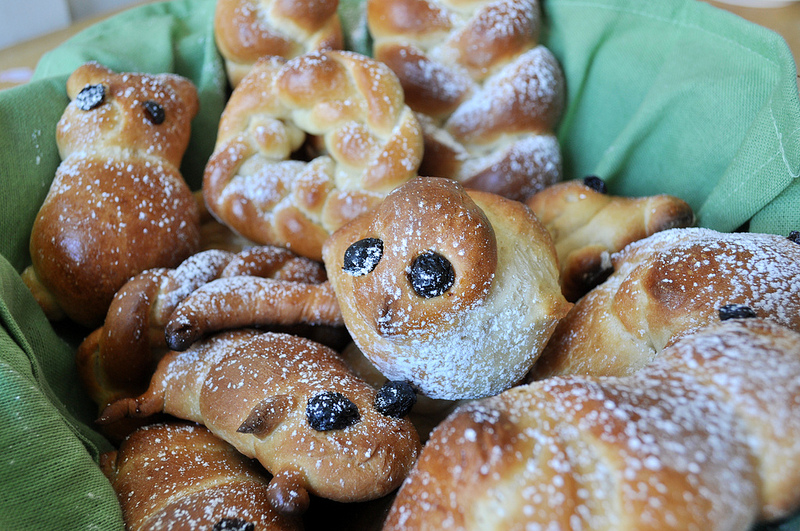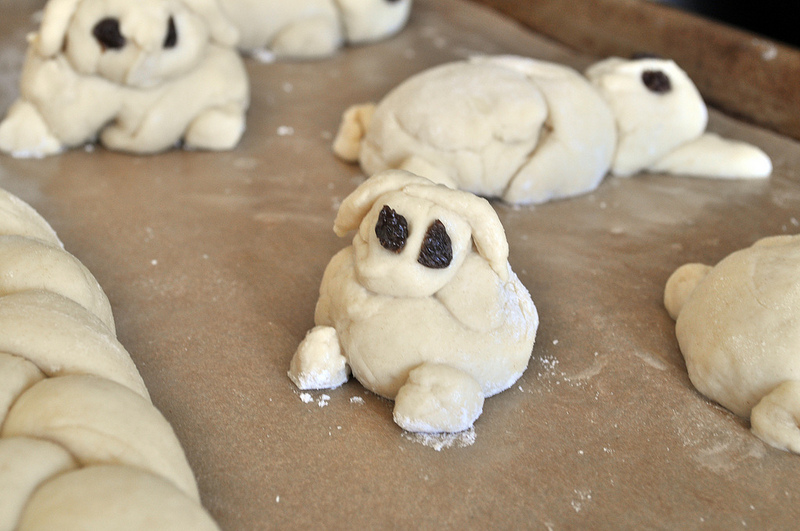
Easter in my Italo-Argentinean household was unlike that of my friends, growing up. There were no basketfuls of plastic pastel eggs, nestled among shiny strands of green, no pink bunnies with pinker nubs for noses, no neon-colored peeps. There were no hunts for brightly colored jelly beans or tiny chocolates wrapped in crinkly purple and blue.
That's not to say we lacked for sweets (no celebration of rebirth could go without), just that ours were different:
The egg, the classic symbol of new life, was represented by a single, beautifully wrapped chocolate egg. The size of small infant, it would be lovingly displayed for days, then unwrapped on Sunday by the smallest child, cracked open to "give birth" to the tiny, colorful sweets contained within, and shared around the table:

The dove, signifying peace and resurrection, appeared as a colomba di pasqua, borrowed from the Italians, and similar to panettone: a yeasty cake, shaped like a dove, laced with candied orange peel and studded with pearl sugar and almonds.
And then, there were our own, homemade, rabbits, made from bread. Our pansitos de pascua, our sweet, eggy Easter bread.

My father is master bread maker, and my brothers and I always looked forward to Holy Saturday morning, when we'd gather around a floured kitchen table and eagerly shape our bit of pan de pascua into tiny little animals, adding bits of raisins for eyes, or corn husks for whiskers.
Sweet, eggy Easter bread isn't necessarily a tradition unique to Italian or Argentinean households -- most cultures that celebrate Easter have their own version. Still, here's ours: a little Córdoba, a little Monza, a little French (the recipe's origin) and even a little Bostonian.
EASTER BREAD
Adapted from the lovely and now out of print Cuisinez avec Silva: Le Pain, by Heidi & Gerold Albonico and Max Pichler
1 kilo all purpose flour
2 teaspoons salt
42 grams fresh yeast (if fresh yeast -- the ideal -- is not available, substitute 16 grams of active dry yeast)
1 tablespoon honey
100 ml water, lukewarm
60 grams of sugar
150 grams unsalted butter, melted
450 ml whole milk
2 large eggs, and a third for painting
Odds and ends for decorating animals - raisins, corn husks, etc.
Powdered sugar, for dusting
1. In a small bowl, dissolve the yeast in the lukewarm water with 1 tablespoon of honey. Set aside for 10 minutes, or until the yeast has foamed. If it doesn't, toss and start again with new yeast.
2. In a medium sized mixing bowl, whisk two eggs lightly with a fork. Add the whole milk and melted butter and whisk until incorporated. Mix in the foamed yeast until just combined.
3. In a large mixing bowl, mix the flour, salt and sugar. Make a well in the middle of the dry ingredients and add the egg mixture. Stir with a wooden spoon until the liquid is absorbed. Begin to knead the dough, adding flour as necessary, until the dough begins to lose its stickiness and handles well. Turn out on a floured surface and knead about 10 minutes more, until dough is smooth and elastic.
4. Put the dough in clean bowl coated thinly with a neutral oil. Cover with a damp towel, and put in a warm place -- ideally, someplace that's roughly 100F -- until it's doubled in size, about one hour. (A warm spot for proofing dough: the microwave with the door ajar. The heat from the lighbulb increases what's otherwise a room temperature hovering around 70F.)
pause
5. Once risen, turn the dough out again onto a floured surface. Punch down to release air pockets, and knead lightly for two minutes, until the dough is back to its original size.
6. And, the fun part: divide the dough into several pieces, and twist into shapes! Two things to keep in mind. First, the shapes should be roughly the same size so that they bake evenly, and second, when affixing small details like eyes or whiskers, keep in mind that the bread will rise a second time and place accordingly.

6. Place pansitos on a baking sheet lined with parchment paper, or that's been buttered. Cover carefully with a thin, lightly dampened towel, and let rise another hour, this time in a cool place to help preserve the shapes. If your cool place is the refrigerator, let rise for two hours.
pause
7. Preheat the oven 375F.
8. Paint the pansitos with the third egg that's been beaten with a bit of water. Bake for a half hour, rotating the pans halfway through. Remove, let cool, dust with a bit of powdered sugar and enjoy.